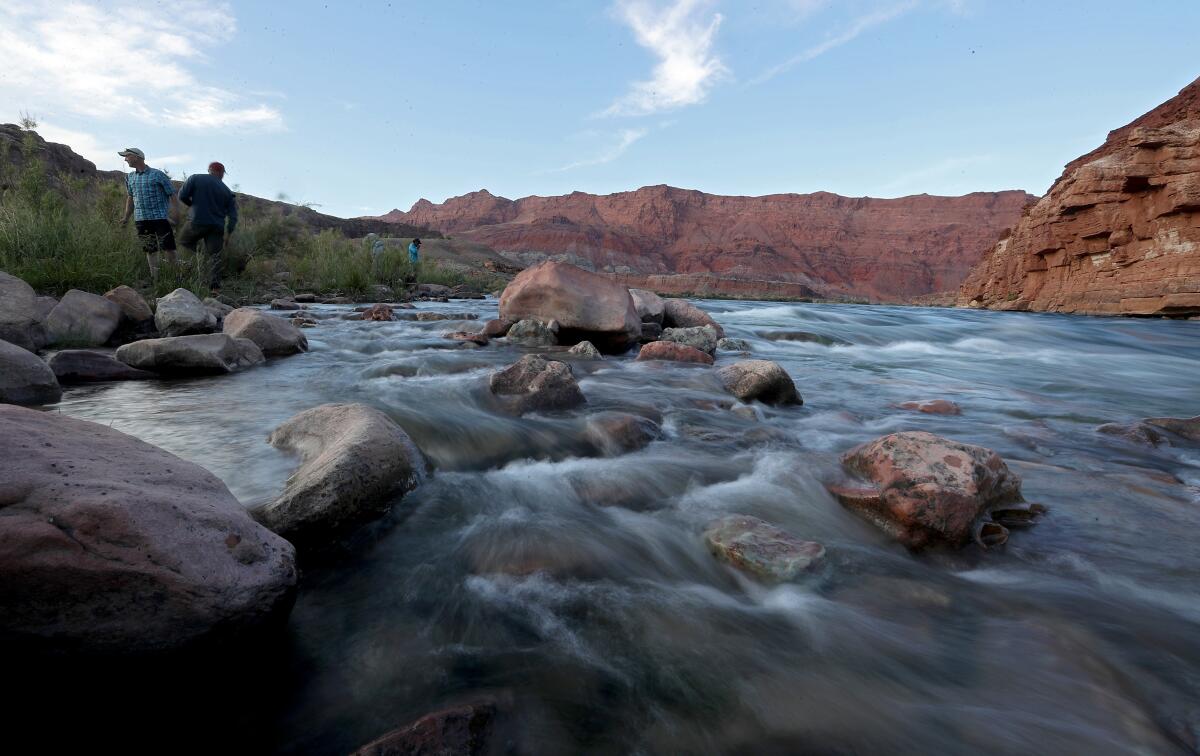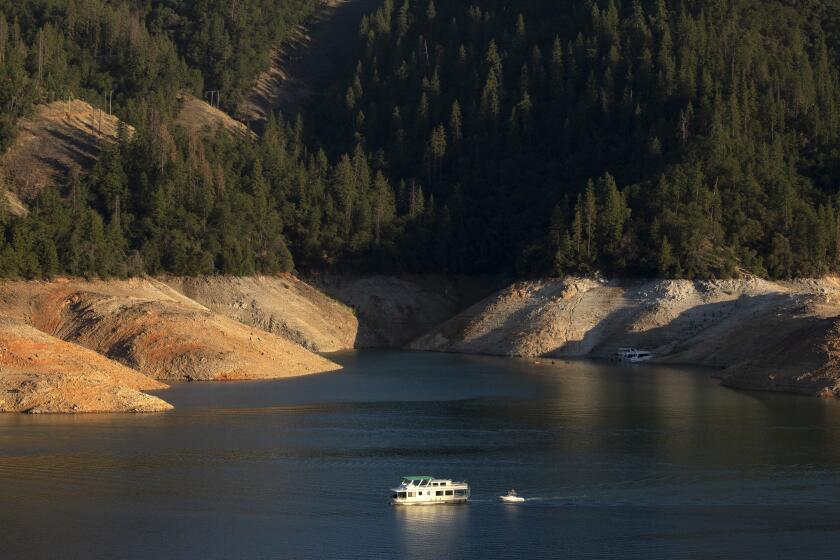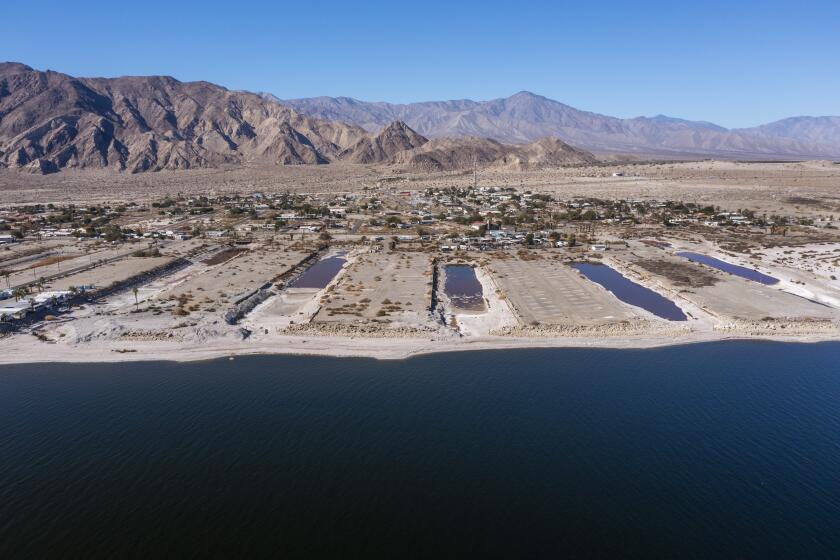More water restrictions likely as California pledges to cut use of Colorado River supply

- Share via
With the Colorado River in crisis and reservoir levels continuing to decline, some California water agencies are planning to significantly reduce the amount they take from the river starting next year.
As a result, officials with the Metropolitan Water District of Southern California said they plan to endorse mandatory conservation measures to begin rationing water for cities and local agencies that supply 19 million people across six counties.
California is entitled to use 4.4 million acre-feet of Colorado River water per year, more than any other state. The water flows through canals to farmlands in Imperial and Riverside counties, and to cities from Los Angeles to San Diego.
Four water districts and the state’s Colorado River Board said in a letter to the federal government on Wednesday that they are proposing to reduce water use by up to 400,000 acre-feet per year. That would amount to about 9% of the state’s total water allotment from the river for the next four years, through 2026.
Residents are conserving water at a commendable pace, but officials say warmer and drier conditions await.
Details of how the water districts will achieve those reductions have yet to be worked out. But the agencies’ leaders said they are preparing to adopt conservation measures that will affect cities as well as farming areas.
“California is stepping up and leading the way on addressing this situation with action and making significant reductions,” said J.B. Hamby, a board member of the Imperial Irrigation District.
Hamby said the reductions “are going to involve serious sacrifice within California, but it’s necessary in order to prevent the system from crashing.”
California water agencies have been under pressure to shoulder substantial water cutbacks. Federal officials in June called for the seven states that rely on the Colorado River to come up with plans to drastically reduce annual water diversions by 2 million to 4 million acre-feet. But negotiations among the states grew tense and acrimonious, and didn’t produce a deal.
Lake Mead and Lake Powell, the river’s two largest reservoirs, now sit nearly three-fourths empty. Without major cuts in water use, the latest projections show growing risks of the reservoirs approaching “dead pool” levels, where water would no longer pass downstream.
California’s pledge remains far from the goal set by federal officials, however, and the state’s water agencies will likely continue to receive pressure to accept larger cuts. But managers of California water agencies said they hope their voluntary proposal will help catalyze water-saving contributions by others across the Colorado River Basin to prevent the reservoirs from bottoming out.
“Basin states need to put historical differences aside and work together to meet this crisis head-on,” Hamby said.
Since 2000, the flow of the river has shrunk dramatically during a megadrought that research shows is being intensified by global warming from the burning of fossil fuels. Scientists have warned that the American West is undergoing climate-driven aridification and will have to adapt to hotter, drier conditions.
As the river’s flow has declined, the states have negotiated deals over the last several years to take less water, while tribes have also participated.
Under a 2019 agreement called the Drought Contingency Plan, Arizona and Nevada are preparing for substantial reductions in water allotments next year. Mexico is also seeing reduced deliveries under a separate deal. California has been spared those cuts so far but has agreed to start taking reductions at lower reservoir levels.
These previous agreements, including another deal reached last year, haven’t been nearly enough to address the gaping imbalance between supply and demand. Reservoir levels have continued to drop to new lows, threatening hydropower production and even potentially putting at risk the continuing flow of the river downstream of Glen Canyon Dam in the Grand Canyon.
“Given dire drought conditions across the region and dangerously low reservoir levels, we firmly believe that all water users within the Basin must take immediate voluntary actions to stabilize water supplies,” leaders of California’s Colorado River Board and four water districts said in their letter to the U.S. Interior Department and the Bureau of Reclamation.
They said that while a multistate agreement has not been reached, California agencies “propose to take voluntary action now” and will seek federal funds in the coming months to support conservation efforts.
Members of the Metropolitan Water District’s staff said they plan to recommend that their board adopt mandatory conservation measures throughout Southern California next year. This will involve cutting deliveries by giving each local supplier a water allocation that they need to stay within.
“We put in place this allocation mechanism whereby any agency that gets water from Metropolitan has to reduce use,” said Deven Upadhyay, the MWD’s assistant general manager.
Upadhyay said the percentage reduction has yet to be determined, and will likely be decided by early next year. Any agency that overuses its water allotment would face penalties, which it would pass on to its customers.
The district similarly rationed water during previous droughts in 2009 and 2015.
As California struggles with an increase in extreme wildfires, researchers are studying exactly what a healthy or fire-resistant forest looks like.
This year, six of the MWD’s 26 member agencies, in parts of Los Angeles, Ventura and San Bernardino counties, are already under mandatory restrictions because only a severely limited supply is available from the State Water Project, which brings water from Northern California.
The new round of conservation measures is expected to expand mandatory restrictions throughout the MWD’s service area.
In recent years, the Metropolitan Water District has also been paying some farmers who agree to leave their fields dry and unplanted. Bill Hasencamp, the MWD’s manager of Colorado River resources, said he and others have been talking with leaders of the Palo Verde Irrigation District, in Blythe, about conserving more water by increasing the fallowing of farmland next year.
Hasencamp said there has been “a lot of finger pointing” by other states directed at California.
“We want to show we’re going to conserve water whether others join us or not,” Hasencamp said. “We’re still in discussions with Arizona to see what Arizona can put on the table.”
Hasencamp said he expects continued criticisms that the reductions aren’t sufficient. At a recent closed-door gathering in New Mexico, he said, representatives of other states urged federal officials to begin to account for evaporation losses from reservoirs and canals, and federal officials said they would develop a proposal for doing that.
At the end of the symposium in Santa Fe, Interior Department officials announced that their next steps will include assessing how to account for and allocate “losses due to evaporation, seepage, and other losses.”
Some Californians want to pump desalinated ocean water to the lake to halt its decline. The state says no.
The proposal has raised concerns for California water managers because including evaporation losses in the accounting could translate into large reductions for the state.
“We’re trying this voluntary approach that can achieve the same savings without having to impose some other type of approach, which might lead to litigation and further acrimony on the river,” Hasencamp said.
The Imperial Irrigation District controls the single largest share of the river, delivering water to farms in the Imperial Valley that produce hay and a wide variety of vegetables, along with other crops. The district has committed to take on the largest share of California’s reductions, up to 250,000 acre-feet of water per year.
“This commitment is contingent upon appropriate funding, voluntary participation from IID’s water users, and necessary environmental permitting,” said Henry Martinez, the IID’s general manager.
Martinez said the district is also pledging to reduce water use based upon a “firm state and federal commitment to address Salton Sea impacts.”
The district’s officials have pointed out that cutting water use will hasten the decline of the Salton Sea, where the receding water leaves exposed lakebed that spews lung-damaging dust. They have demanded funding for projects at the lake to control dust and create habitat for birds.
The federal government has funds available from the newly passed Inflation Reduction Act, which included $4 billion for drought response and conservation programs. Some of the money may be used across the region to pay farmers and others to voluntarily use less water.
But IID officials have said they plan to prioritize conservation efforts based on improving water efficiency, rather than fallowing fields, because that will allow growers to continue farming.
These new conservation programs have yet to be approved by the district’s board.
Peter Osterkamp, a farmer whose great-grandfather started farming in the Imperial Valley in 1946, said he has been working for years to conserve water while growing crops including carrots, onions, sugar beets, broccoli seed, durum wheat, silage corn, alfalfa and Bermuda grass.
Osterkamp has built so-called tail-water recovery systems, which capture and store water that drains off fields for reuse. He said these systems have effectively improved crop yields and conserved a lot of water. He has also turned to water-saving sprinkler systems.
He said these types of changes have great potential to save water while sustaining farming, and he thinks the Imperial Irrigation District should keep developing a plan to make conservation projects a priority.
“As we build more tail-water recovery systems, buy more sprinkler equipment, install more drip systems, concrete-line ditches and install more subsurface drainage, we will prevent significant risks for our food production,” Osterkamp said.
He estimates that every four acres of farmland with a tail-water recovery system saves about as much water as leaving one acre dry and fallow. More financial assistance for such projects, he said, would help further increase conservation.
“Fallowing, to me, is giving up. And that’s not the solution for us. I mean, it may help in the short term, but not long term,” Osterkamp said.
“We just want to farm,” he said. “My role is to grow food and conserve as much water as possible.”
More to Read
Sign up for Essential California
The most important California stories and recommendations in your inbox every morning.
You may occasionally receive promotional content from the Los Angeles Times.














